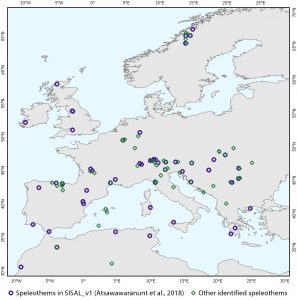Cave Deposits as Recorders of Past Climates

Speleothems, more commonly known as stalagmites and stalactites, are inorganic deposits that grow in caves and form from dripping waters super-saturated with respect to calcium carbonate (CaCO3). Speleothems which grow up from the ground are called stalagmites and those which grow down from the roof of caves are called stalactites. They provide useful archives of past climate, or palaeoclimate, as they preserve aspects of the cave drip water geochemical composition and therefore provide information about the overlying climate, vegetation and soil.
The Greek prefix ‘palaeo’ means ‘ancient’. Palaeoclimate is the reconstruction and study of past climate states on Earth. The major strength of speleothems is that it is possible to determine their age accurately, thus making them good for reconstructing climates that happened abruptly or within short periods of time. They are well distributed worldwide and hence, are valuable for reconstructing the climate of a specific region and at the same time they allow comparisons of climate changes to be made across continents
Different types of measurements are made on speleothems with the most common being:
- stable isotopes of oxygen and carbon
- changes in annual growth rate and
- concentrations of various trace elements.
They also provide a wealth of information about past changes in the hydrological cycle, changes in atmospheric composition and the local environment. These measurements provide a record of significant events which occurred in the past, such as changes in the Saharo-Arabian desert that enabled migration of humans out of Africa, transitions between glacial and interglacial periods, and variations in the North Atlantic Oscillation (NAO), one of the atmospheric circulation patterns that controls much of Europe’s winter climate.
Understanding past climate changes is crucial, because it serves as a reference for current and future changes in climate. Speleothems are one of the few data sources that can be used to test the ability of climate models to capture climate variability at century or millennium time scales, although this has rarely been done because of the lack of a global synthesis of the records. Over 700 speleothem records have been published over the past few decades but only 7 of these are included in the global Palaeoclimate Model Intercomparison Project (PMIP). For this reason, scientists working with such very old records, palaeorecords, are making increased efforts to produce homogeneous datasets that can be used to verify climate model outputs.
SISAL (Speleothem Isotopes Synthesis and Analysis), a community-based working group, sponsored by PAGES, has just created a global synthesis of speleothem records, following the FAIR Guiding Principles for scientific data; namely, that all research data and products should be Findable, Accessible, Interoperable and Reusable (FAIR), both for computers and for people. Because of the complex way in which palaeorecords reflect the changes in the overlying climate, it is particularly important that these records are standardised by the experts that collect, analyse and interpret them. This dataset will contribute towards the understanding of past climate variability by providing data to assess the output of climate models.
Dr Laia Comas-Bru, University of Reading, UK


Kommentare sind geschlossen.